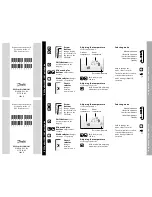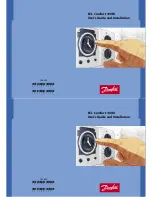
18
Temperature Controllers
E5CSZ
9. Use the product within the rated load and power supply.
10.Use a switch, relay, or other contact so that the power supply
voltage reaches the rated voltage within 2 seconds. If the applied
voltage is increased gradually, the power supply may not be reset
or malfunctions may occur.
11.When using PID operation (self-tuning), turn ON the power supply
to the load (e.g., heater) at the same time or before turning the
power supply to the Temperature Controller ON. If power is turned
ON for the Temperature Controller before turning ON power
supply to the load, self-tuning will not be performed properly and
optimum control will not be achieved.
12.Design the system (e.g., control panel) to allow for the 2 seconds
of delay required for the Temperature Controller's output to
stabilize after the power is turned ON.
13.A switch or circuit breaker should be provided close to this unit.
The switch or circuit breaker should be within easy reach of the
operator, and must be marked as a disconnecting means for this
unit.
14.Approximately 30 minutes is required for the correct temperature
to be displayed after turning the power supply to the Temperature
Controller ON. Turn the power supply ON at least 30 minutes prior
to starting control operations.
15.Be sure that the platinum resistance thermometer type and the
input type set on the Temperature Controller are the same.
16.When extending the thermocouple lead wires, always use
compensating conductors suitable for the type of thermocouple.
Do not extend the lead wires on a platinum resistance
thermometer. Use only low-resistance wire (5
Ω
max. per line) for
lead wires and make sure that the resistance is the same for all
three wires.
17.When drawing out the Temperature Controller from the case, do
not apply force that would deform or alter the Temperature
Controller.
18.When drawing out the Temperature Controller from the case to
replace the Temperature Controller, check the status of the
terminals. If corroded terminals are used, contact faults with the
terminals may cause the temperature inside the Temperature
Controller to increase, possibly resulting in fire. If the terminals
are corroded, replace the rear case as well.
19.When drawing out the Temperature Controller from the case, turn
the power supply OFF first, and absolutely do not touch the
terminals or electronic components or apply shock to them. When
inserting the Temperature Controller, do not allow the electronic
components to come into contact with the case.
20.Static electricity may damage internal components. Always touch
grounded metal to discharge any static electricity before handling
the Temperature Controller. When drawing out the Temperature
Controller from the case, do not touch the electronic components
or patterns on the board with your hand. Hold the Temperature
Controller by the edge of the front panel when handling it.
21.Do not use paint thinner or similar chemical to clean with. Use
standard grade alcohol.
22.Use tools when separating parts for disposal. Contact with the
sharp internal parts may cause injury.
■
Precautions for Correct Use
Service Life
Use the Temperature Controller within the following temperature and
humidity ranges:
Temperature:
−
10 to 55
°
C (with no icing or condensation)
Humidity:
25% to 85%
If the Controller is installed inside a control board, the ambient
temperature must be kept to under 55
°
C, including the temperature
around the Controller.
The service life of electronic devices like Temperature Controllers is
determined not only by the number of times the relay is switched but
also by the service life of internal electronic components. Component
service life is affected by the ambient temperature: the higher the
temperature, the shorter the service life and, the lower the
temperature, the longer the service life. Therefore, the service life
can be extended by lowering the temperature of the Temperature
Controller.
When two or more Temperature Controllers are mounted horizontally
close to each other or vertically next to one another, the internal
temperature will increase due to heat radiated by the Temperature
Controllers and the service life will decrease. In such a case, use
forced cooling by fans or other means of air ventilation to cool down
the Temperature Controllers. When providing forced cooling,
however, be careful not to cool down the terminals sections alone to
avoid measurement errors.
Measurement Accuracy
When extending or connecting the thermocouple lead wire, be sure
to use compensating wires that match the thermocouple type. Do not
extend the lead wire of the platinum resistance thermometer. If the
lead wire of the platinum resistance thermometer must be extended,
be sure to use wires that have low resistance and keep the
resistance of the three lead wires the same.
Mount the Temperature Controller so that it is horizontally level.
If the measurement accuracy is low, check whether the input shift
has been set correctly.
Содержание E5CSZ
Страница 19: ...Temperature Controllers E5CSZ 19 ...



































